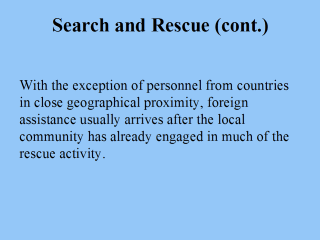 |
For example, in
southern Italy, in 1980, 90% of the survivors of an earthquake were
extricated by untrained, uninjured survivors who used their bare hands and
simple tools such as shovels and axes (111). Following the 1976
Tangshan earthquake, about 200,000 to 300,000 entrapped people crawled out
of the debris on their own and went on to rescue others (6). They
became the backbone of the rescue teams, and it was to their credit that
more than 80% of those buried under the debris were rescued. Thus,
lifesaving efforts in a stricken community rely heavily on the capabilities
of relatively uninjured survivors, including untrained volunteers, as well
as those of local firefighters and other relevant professionals (113).
This does not mean that people who were dead when they were extricated could
not have been saved by a skilled team with sophisticated resources. However,
people from the community clearly play the most important role in rescue
efforts, if they are appropriately prepared. |
